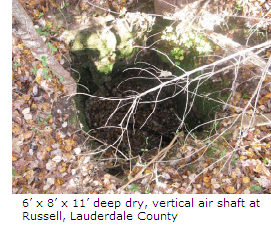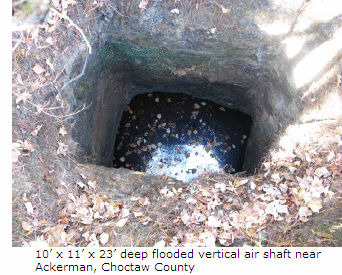100 YEAR OLD COAL MINES IN MISSISSIPPI?
By Stan Thieling, Office of Geology

Many Mississippians are surprised to hear that there is a
coal (lignite) mine in Mississippi. It just isn’t the kind
of thing we think of as being here; maybe Alabama, but
not here. There really is a 5,900 acre surface coal mine
in Choctaw County, five miles north of Ackerman, and
it has been in operation for nearly ten years.
An even greater surprise would be finding out that 100
years ago there were a number of lignite mines around
the state. Granted, these mines were very small and
short lived, but some did exist.
Because of the poor environmental history of the mining industry in general, and the coal mining industry in particular, beginning in 1977, as part of the Surface Mining Control and Reclamation Act (SMCRA), Congress authorized the Office of Surface Mining Reclamation and
Enforcement (OSM) to assess a per-ton production fee on all present-day coal mines. The funds generated by this fee are to be used to reclaim environmental problems at historic coal mines. Historic coal mines are those which existed before 1977 and did not have a reclamation bond under SMCRA.
Mississippi was the third state to gain primacy from OSM under SMCRA, which happened in 1980. Primacy is the authority to regulate coal mining within the state. This authority includes the ability to establish an Abandoned Mine Land (AML) program. Although Mississippi had primacy in 1980, the first coal mining permit was not applied for until 1997 and issued until 1998. The AML funds generated by production at this mine were reserved for Mississippi by OSM. Mississippi’s AML plan was approved by OSM in September 2007; DEQ received the first AML grant beginning in February 2008. This initial AML grant was to do research and assemble an inventory of abandoned coal mine sites which would be eligible for reclamation by DEQ under this grant.
Publications by the Office of Geology’s in-name predecessors, the Bureau of Geology and the Geological Survey, have published references to lignite in Mississippi as far back as the 1850s. Reports of lignite mining go back to the early 1900s. There apparently was a time in the very late 1800s and early 1900s when a boom period existed for attempts at coal mining within Mississippi. Records from the Department of Archives and History tell a story of a number of somewhat shady “investment” schemes. Unsuspecting investors may have been scammed when promoted and promised mining never materialized. However, a number of legitimate companies did exist and attempted to establish successful, commercial mines. Some of the companies involved include the Mississippi Oil and Gas Co-operative Joint Stock Company, the Meridian Fertilizer Company, and the Gulf, Mobile, & Northern Railroad.

Vertical air shafts into former underground coal mines have been found east of Meridian at Russell and near Ackerman. Much searching has not found the entrance to either of these mines, indicating that they have probably collapsed. Collapse would not be too surprising considering that the “roof” of each mine would have been made of clay, not rock. An underground mine still exists near Louisville. No air shaft has been found, but the entrance to the mine is still open. A part of the mine “roof” at the entrance has collapsed, creating a dam which has trapped rain and ground water, flooding the floor of the mine. The size of these mines is unknown, but all are believed to be small by modern standards, likely less than 1-2 acres. However, at least one was large enough to have been described as using “room
and pillar mining,” a common method still used today. One small surface coal mine is well known locally at Reform. Covering about a half acre, it is still used today as a fishing pond.

It is DEQ’s intent, given landowner permission, to reclaim these sites to eliminate hazardous situations. The air shafts are 11 and 23 feet deep with vertical walls. Anyone accidentally falling into one of them would be trapped if they were alone. The remainder of the roof of the mine near Louisville could collapse at any time and crush or trap anyone in it. Fishing in the shallow surface mine near Reform is not planned to be disturbed.

|
SOURCE: http://www.deq.state.ms.us/MDEQ.nsf/pdf/Main_022009MDEQNewsletterVol6Issue2/$File/Vol. 6 Issue 2extEdit.pdf
|
 Many Mississippians are surprised to hear that there is a
coal (lignite) mine in Mississippi. It just isn’t the kind
of thing we think of as being here; maybe Alabama, but
not here. There really is a 5,900 acre surface coal mine
in Choctaw County, five miles north of Ackerman, and
it has been in operation for nearly ten years.
Many Mississippians are surprised to hear that there is a
coal (lignite) mine in Mississippi. It just isn’t the kind
of thing we think of as being here; maybe Alabama, but
not here. There really is a 5,900 acre surface coal mine
in Choctaw County, five miles north of Ackerman, and
it has been in operation for nearly ten years.
 Vertical air shafts into former underground coal mines have been found east of Meridian at Russell and near Ackerman. Much searching has not found the entrance to either of these mines, indicating that they have probably collapsed. Collapse would not be too surprising considering that the “roof” of each mine would have been made of clay, not rock. An underground mine still exists near Louisville. No air shaft has been found, but the entrance to the mine is still open. A part of the mine “roof” at the entrance has collapsed, creating a dam which has trapped rain and ground water, flooding the floor of the mine. The size of these mines is unknown, but all are believed to be small by modern standards, likely less than 1-2 acres. However, at least one was large enough to have been described as using “room
and pillar mining,” a common method still used today. One small surface coal mine is well known locally at Reform. Covering about a half acre, it is still used today as a fishing pond.
Vertical air shafts into former underground coal mines have been found east of Meridian at Russell and near Ackerman. Much searching has not found the entrance to either of these mines, indicating that they have probably collapsed. Collapse would not be too surprising considering that the “roof” of each mine would have been made of clay, not rock. An underground mine still exists near Louisville. No air shaft has been found, but the entrance to the mine is still open. A part of the mine “roof” at the entrance has collapsed, creating a dam which has trapped rain and ground water, flooding the floor of the mine. The size of these mines is unknown, but all are believed to be small by modern standards, likely less than 1-2 acres. However, at least one was large enough to have been described as using “room
and pillar mining,” a common method still used today. One small surface coal mine is well known locally at Reform. Covering about a half acre, it is still used today as a fishing pond. It is DEQ’s intent, given landowner permission, to reclaim these sites to eliminate hazardous situations. The air shafts are 11 and 23 feet deep with vertical walls. Anyone accidentally falling into one of them would be trapped if they were alone. The remainder of the roof of the mine near Louisville could collapse at any time and crush or trap anyone in it. Fishing in the shallow surface mine near Reform is not planned to be disturbed.
It is DEQ’s intent, given landowner permission, to reclaim these sites to eliminate hazardous situations. The air shafts are 11 and 23 feet deep with vertical walls. Anyone accidentally falling into one of them would be trapped if they were alone. The remainder of the roof of the mine near Louisville could collapse at any time and crush or trap anyone in it. Fishing in the shallow surface mine near Reform is not planned to be disturbed.
